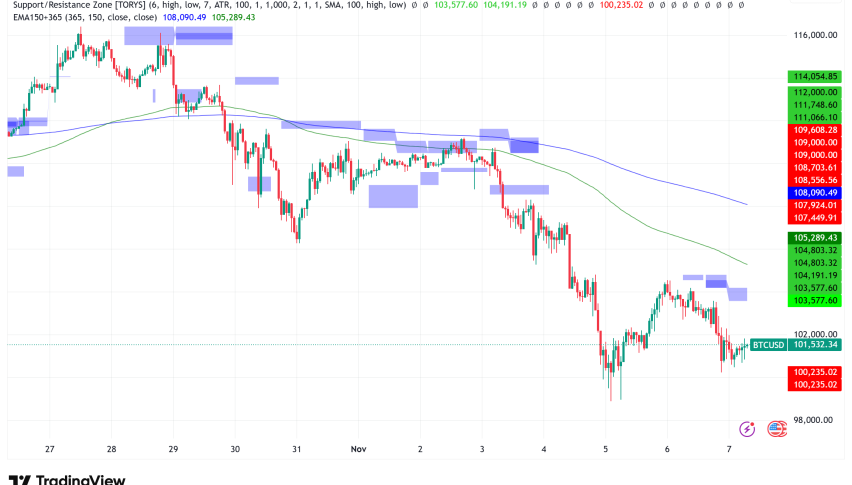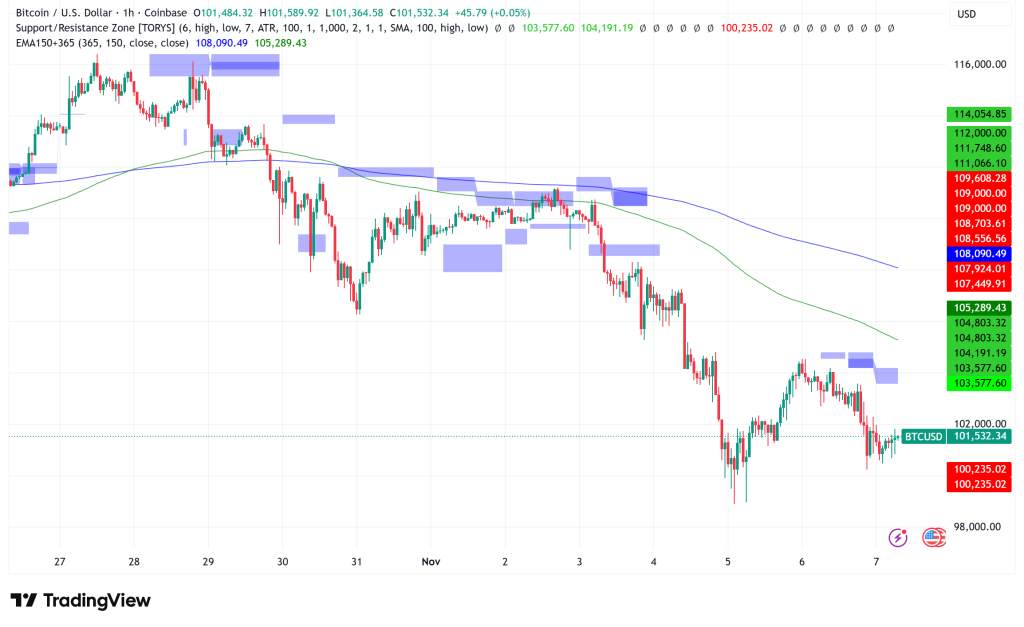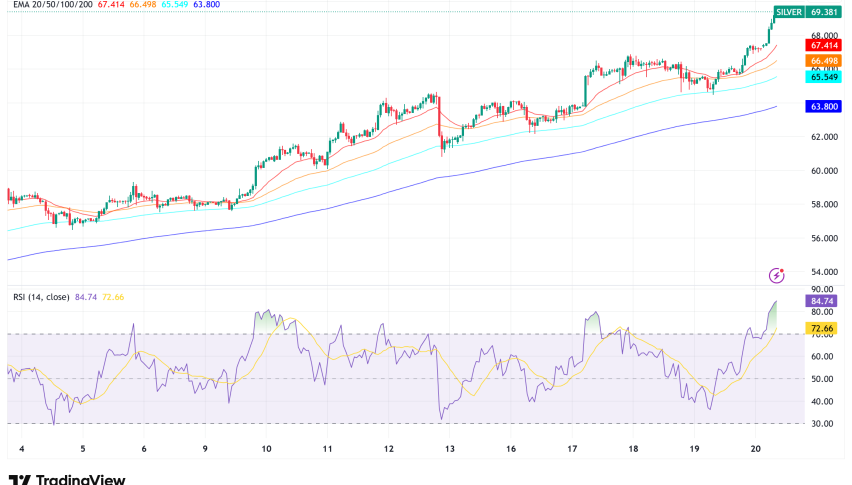Bitcoin Battles Macro Headwinds: JPMorgan Sees $170K Upside Amid $100K Support Test
Bitcoin is now trading over $101,000, which is a small 1.6% increase in value over the past 24 hours. But beyond this surface stability

Quick overview
- Bitcoin is currently trading above $101,000, reflecting a modest 1.6% increase in the last 24 hours amidst mixed market signals.
- JPMorgan projects a potential upside for Bitcoin to around $170,000 based on its volatility compared to gold, indicating it may be undervalued.
- Institutional demand for Bitcoin is waning, with significant outflows from spot Bitcoin ETFs and a revised price target from Galaxy Digital.
- Analysts suggest that Bitcoin's recovery hinges on stabilizing ETF flows and improving economic conditions, with the $100,000 support level being crucial.
Bitcoin BTC/USD is now trading above $101,000, which is a small 1.6% increase in value over the past 24 hours. But beyond this surface stability, the market is dealing with mixed signals, such as JPMorgan’s positive long-term valuation and growing worries among institutions about macro headwinds and a lack of liquidity.

JPMorgan Projects 67% Upside Based on Gold Volatility Ratio
In a report released on Wednesday, JPMorgan analysts said that Bitcoin has “significant upside” over the next 6 to 12 months, with a notional fair value of around $170,000. Their study focuses on the bitcoin-to-gold volatility ratio, which has dropped to 1.8. This means that BTC is now 1.8 times more risky than gold.
The company’s study says that gold’s recent rise to all-time highs in October came with more volatility, which makes the commodity more risky. JPMorgan said, “Considering this volatility ratio, which means that bitcoin uses 1.8 times more risk capital than gold, the market cap of bitcoin at $2.1 trillion would have to rise by almost 67%.”
This analysis, which takes into account volatility, shows that Bitcoin may be undervalued compared to gold when looking at risk, which might make it a better investment for institutions who are willing to take on greater risk and are looking for other assets.
BTC/USD Technical Analysis: Critical Support Levels Under Pressure
Even while JPMorgan is positive about the long-term future of Bitcoin, it has some technical problems that need to be fixed right away. On Tuesday, the cryptocurrency momentarily dropped below $100,000, its first time breaking this psychological barrier in four months. More importantly, it slipped below its 365-day moving average, which is close to $102,000.
CryptoQuant, a market analytics company, stressed how important this news is. They pointed out that the 365-day moving average has been a key support level during the current bull cycle. The company said that if this level isn’t regained, it could mean that a bigger downturn is coming.
Thursday’s retest of the $101,500 support level caused almost $135 million in liquidations from leveraged long positions. At the same time, Bitcoin’s monthly futures premium fell below 5%, which means that demand for bullish exposure is diminishing. The options market reflects a similar story: demand for put options shot up, pushing the delta skew to 14%, which is much higher than the neutral 6% level.
Institutional Demand Wanes as Bitcoin ETF Outflows Accelerate
The fact that people are still leaving spot Bitcoin ETFs is probably the most worrying thing for Bitcoin bulls. Since October 29, these products have lost around $2 billion in assets, which was one of the market’s greatest tailwinds in 2025.
Galaxy Digital cut its Bitcoin price target for the end of the year from $185,000 to $120,000 because of the “significant leverage wipeout” that happened after the historic liquidation event on October 10, when about $20 billion in leveraged positions across crypto were unwound in 24 hours.
Alex Thorn, who is in charge of research at Galaxy, called the current situation Bitcoin’s “maturity era,” where “institutional absorption, passive flows, and lower volatility dominate.” The consequence is that the huge gains of past cycles may give way to slower, steadier growth as ETFs take up all the available supply.
Macro Uncertainty Compounds Crypto-Specific Challenges
Bitcoin’s problems are happening at the same time as a lot of other market worries. The Nasdaq declined 1.6% this week, and the semiconductor giants Qualcomm and AMD plummeted 5% and 7.5%, even though they both had good profits. This is because people are worried about high valuations and problems with AI chip production.
Also, the continuing U.S. government shutdown has hurt consumer spending, as shown by poor quarterly results from companies like DoorDash, Pinterest, and Duolingo. The Federal Reserve’s careful approach after cutting rates in October, together with the Supreme Court’s review of the president’s power to set tariffs, has made people even less willing to take risks.
Notably, Bitcoin futures open interest stayed the same even though the price fell to $100,300 on Thursday. This suggests that traders added margin instead of closing positions, which is a tentative hint that $100,000 support will hold.
Bitcoin Outlook: Stabilization Required Before Bulls Return
Analysts agree that a number of things need to happen for Bitcoin to make a long-term recovery. CryptoQuant says that ETF outflows need to start going up again and people need to have more faith in risk assets for things to change. The company says that even while the overall economy is still “supportive,” it is hard to get clear information on policy. Markets only see a 60–65% chance of another Fed rate drop in December.
The difference between JPMorgan’s fair value of $170,000 and Galaxy’s year-end target of $120,000 shows how unstable the crypto markets are. Volatility-adjusted indicators point to long-term value, while near-term technicals and liquidity dynamics show a more unstable picture.
Before trying to get back to the $110,000 mark and higher, Bitcoin bulls will probably need compelling proof that ETF flows are stabilizing and the economy is doing better. The $100,000 psychological support level is still the line in the sand until then. If corporate results keep underperforming or macro shocks happen, there might be more loss.
- Check out our free forex signals
- Follow the top economic events on FX Leaders economic calendar
- Trade better, discover more Forex Trading Strategies
- Open a FREE Trading Account


